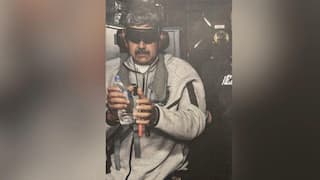EXPLAINED | NASA's SpaceX Crew-4 Mission To Lift Off On April 27. All You Need To Know
NASA astronauts Kjell Lindgren, Bob Hines, and Jessica Watkins, and European Space Agency astronaut Samantha Cristoforetti will launch aboard a SpaceX Crew Dragon spacecraft, atop a Falcon 9 rocket.

New Delhi: Four astronauts are set to blast off into space on Wednesday, April 27, as part of NASA's SpaceX Crew-4 mission.
This is the fourth crew rotation mission that will ferry an international crew of four astronauts on a science expedition to the International Space Station (ISS).
NASA astronauts Kjell Lindgren, Robert Hines, and Jessica Watkins, and European Space Agency (ESA) astronaut Samantha Cristoforetti will launch aboard a SpaceX Crew Dragon spacecraft, atop a Falcon 9 rocket, from the historic Launch Complex 39-A at NASA's Kennedy Space Center in Florida. The mission is scheduled to lift off on April 27, at 3:52 am ET (1:22 pm IST).
Crew-4 mission is the fourth crew rotation to fly on a SpaceX Crew Dragon spacecraft and Falcon 9 rocket, and the fifth SpaceX flight with NASA astronauts, as part of the US space agency's Commercial Crew Program.
The astronauts will conduct several science experiments aboard the microgravity laboratory, during their four-and-a-half month stay. They will return to Earth in the fall of 2022.
Crew-4 will be launched aboard a new Crew Dragon spacecraft. The astronauts named the spacecraft "Freedom" to celebrate a fundamental right, and the industry and innovation that emanate from the untainted human spirit, NASA said on its website.
Overview Of Crew-4 Mission
The Crew Dragon "Freedom" spacecraft will accelerate the four passengers to approximately 17,500 miles per hour. Once the astronauts enter Earth's orbit, SpaceX mission control will monitor a series of automatic manoeuvres, which will guide them to the forward end of the space station's Harmony module. Though the spacecraft is designed to rock autonomously into the space station, the astronauts can take control and pilot it manually, if necessary.
After docking is complete, the seven-member crew of Expedition 67 will welcome the Crew-4 astronauts inside the microgravity laboratory. Several days after the arrival of Crew-4, the astronauts of NASA's SpaceX Crew-3 mission will depart from the space station.
Scientific Research To Be Conducted By Crew-4
The Crew-4 astronauts will conduct new and interesting scientific research in different areas, and several experiments. The research areas include materials science, health technologies, and plant science to prepare for human exploration beyond low-Earth orbit and benefit life on Earth.
The astronauts will conduct experiments such as studies on the ageing of immune systems, organic material concrete alternatives, and cardiorespiratory effects during and after long-duration exposure to microgravity, according to NASA. Overall, more than 200 science experiments and technology demonstrations will be conducted during their mission.
As part of the German Space Agency (DLR) investigation called Wireless Compose-2, Smart-Tex shirts are travelling to space aboard the Crew Dragon spacecraft. The main scientific goal of the Wireless Communication Network (Wireless Compose-2) investigation is to provide a flexible and adaptable wireless network infrastructure to conduct and execute low-power and wireless experiments on the space station. The Smart Shirt is a wearable health monitoring system by American firm Sensatex, which monitors heart rate, body temperature, and motion of the trunk.
The shirts are fitted with sensors, wiring, and a communications module to wirelessly transmit data to a base station, and are designed to monitor cardiovascular activity like relative blood pressure. The shirts can provide information about heart contraction rate and valve opening and closing times, which are normally accessible only through sonography or computed tomography (CT) scans. Thus, Smart Shirts are wearable technologies which could be used to monitor health throughout a long-duration space exploration mission.
The Crew-4 astronauts will also conduct a pair of spacewalks to continue preparing the station for new solar arrays which will increase the orbital laboratory's total available power supply.
Meet The Crew-4 Astronauts
In February 2021, Lindgren and Hines were assigned to the Crew-4 mission. Since then, they have been working and training for their stay aboard the orbital laboratory. Cristoforetti and Watkins were assigned to the mission in March and November 2021, respectively.
Kjell Lindgren
Lindgren, who is the commander of the "Freedom" spacecraft and the Crew-4 mission, is responsible for all phases of flight, from launch to entry. Once Crew-4 astronauts reach the space station, they will join Expedition 67.
Lindgren will serve as a flight engineer aboard the microgravity laboratory. He became an astronaut in 2009, and Crew-4 will be his second spaceflight since then.
In 2015, he served as a flight engineer for Expeditions 44 and 45, during which he spent 141 days aboard the orbital outpost.
Lindgren, who is board certified in emergency medicine, previously worked at NASA's Johnson Space Center in Houston as a flight surgeon supporting space station training and operations, and served as the Deputy Crew Surgeon for space shuttle flight STS-130 and Expedition 24. He graduated from the US Air Force Academy in 1995.
Robert Hines
Hines will serve as the pilot of the "Freedom" spacecraft. He is the second in command for the Crew-4 mission, and is responsible for spacecraft systems and performance.
He will serve as Expedition 67 flight engineer onboard the space station. The Crew-4 mission will be his first flight since being selected as an astronaut in 2017. He was a research pilot at Johnson before his selection as an astronaut. He has served more than 22 years in the US Air Force as a test pilot, fighter pilot, and instructor pilot.
Hines has recorded more than 3,500 hours of flight time in 50 different types of aircraft. He has flown 76 combat missions in three different types of aircraft, according to NASA.
Samantha Cristoforetti
Cristoforetti will serve as a mission specialist, and will be an Expedition 67 flight engineer aboard the space station. She will work to monitor the "Freedom" spacecraft during the dynamic launch and reentry phases of flight.
In 2015, Cristoforetti spent five months aboard the orbital laboratory as a flight engineer for Expeditions 42 and 43. Crew-4 will be her second spaceflight since her mission aboard the ISS in 2015.
Cristoforetti was selected as an ESA astronaut in 2009. Prior to this, she served as a fighter pilot in the Italian Air Force.
In 2019, Cristoforetti served as commander for NASA's 23rd Extreme Environment Mission Operations mission on a 10-day stay in Aquarius, which is the only undersea research station in the world.
Watkins will serve as a mission specialist for Crew-4. Working closely with the commander and pilot, she will monitor the spacecraft during the dynamic launch and reentry phases of flight. She is set to become the first Black woman to join NASA's Commercial Crew Program for a long duration mission.
Jessica Watkins
Watkins will serve as an Expedition 67 flight engineer, once aboard the station. In 2017, she was selected as a NASA astronaut. Crew-4 mission will be her first spaceflight.
Watkins studied geology at Stanford University, Palo Alto, California, and the University of California, Los Angeles. She has studied the surface of Mars and was a science team collaborator for the Curiosity rover.
At the conclusion of the Crew-4 mission, the "Freedom" spacecraft will undock with the four astronauts aboard, depart the space station, reenter Earth's atmosphere, and splashdown off the coast of Florida.
Related Video
Southern Rising Summit 2024: How Important is Self-Awareness? Insights from Anu Aacharya | ABP LIVE






































